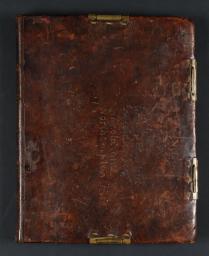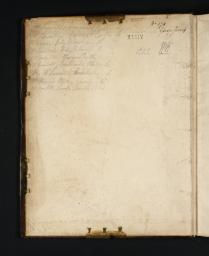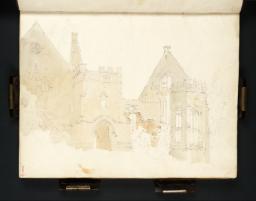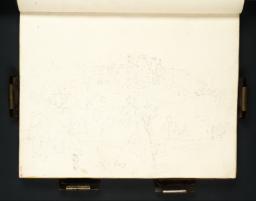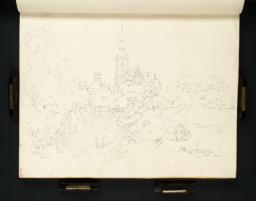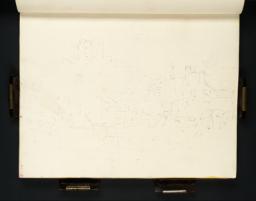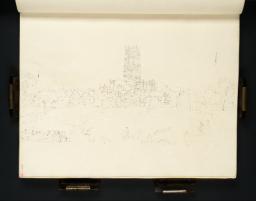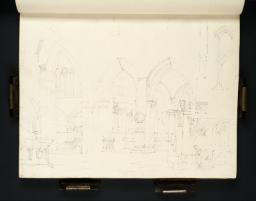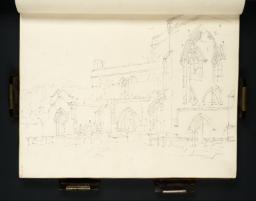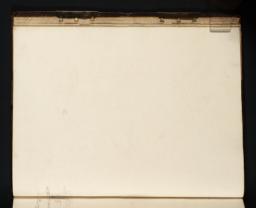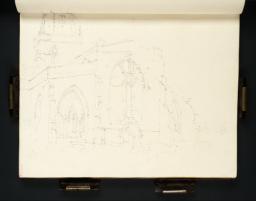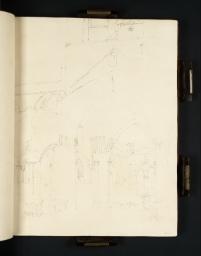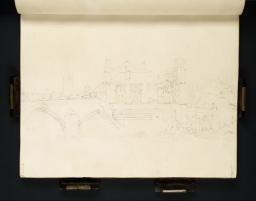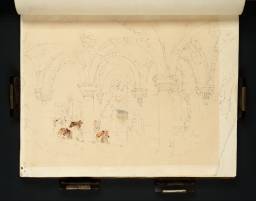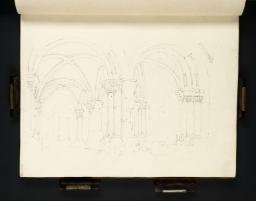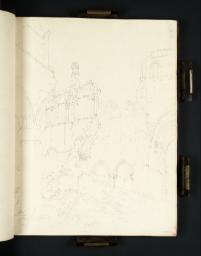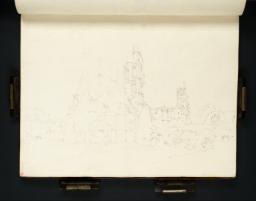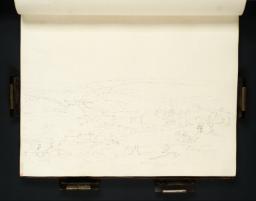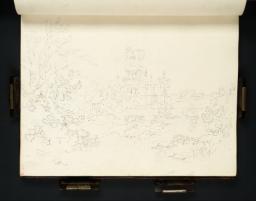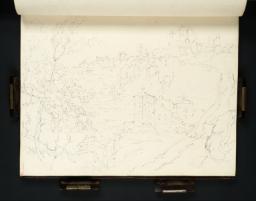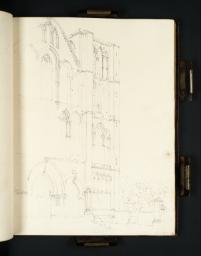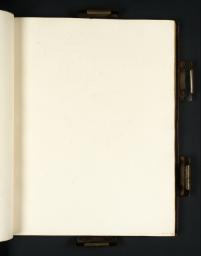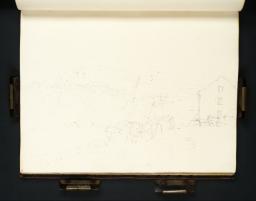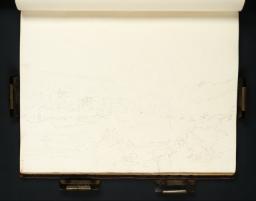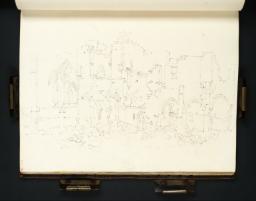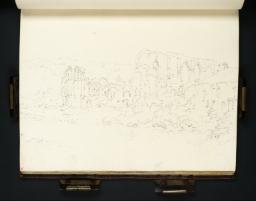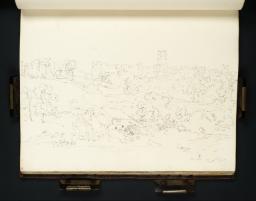Turner Bequest XXXIV 1–91
Sketchbook bound in boards covered in brown calf leather with four brass clasps
95 leaves, the remnant of another (D00940), and one flyleaf of white wove paper; various leaves watermarked ‘1794 | J Whatman’; page size 270 x 210 mm
Inscribed by Turner in brush and ?gouache ‘Derbyshire | Yorkshire | Durham | Northumberland | Tweeddale Scot | Lincolnshire | Northamptonshire’ on front cover (D40560)
Numbered 178 as part of the Turner Schedule in 1854, and endorsed by the Executors of the Turner Bequest inside front cover (D41412)
95 leaves, the remnant of another (D00940), and one flyleaf of white wove paper; various leaves watermarked ‘1794 | J Whatman’; page size 270 x 210 mm
Inscribed by Turner in brush and ?gouache ‘Derbyshire | Yorkshire | Durham | Northumberland | Tweeddale Scot | Lincolnshire | Northamptonshire’ on front cover (D40560)
Numbered 178 as part of the Turner Schedule in 1854, and endorsed by the Executors of the Turner Bequest inside front cover (D41412)
Accepted by the nation as part of the Turner Bequest 1856
Exhibition history
References
This is an important book, the size of the South Wales and Isle of Wight sketchbooks used in 1795 (Tate; Turner Bequest XXVI, XXIV) and containing many drawings in pencil, but also with a longer and more impressive series of watercolour studies than any earlier book. The itinerary that Turner planned for the summer of 1797 was calculated to include a wide range of famous locations: the ruined monastic buildings of Yorkshire and the Tweed Valley, and the celebrated scenery of the Lake District. As David Hill observes, the journey ‘was one of the most important tours of his career’;1 he computes that Turner made over 200 sketches during a journey of 1,000 miles,2 and goes on to suggest that it ‘marked the origin of his success.’ Turner had already made some views of northern towns in the course of his work for John Walker’s Copper Plate Magazine; plates of Carlisle, Wakefield and Sheffield appeared in 1797–8, engraved from drawings (the first two currently untraced, the latter in the Museums Sheffield collection)3 which he must have made some time previously, on the basis of other artists’ work. His colleague Thomas Girtin (1775–1802) had made a tour of the north of England and the borders in the previous year, and Turner no doubt acquired information as well as inspiration from him. Hill4 suggests that the two artists were actually together at Harewood House, near Leeds, this year. The commission to make views at Harewood for the Lascelles family (see list of miscellaneous commissions inside the front cover, D40560) was evidently an important incentive for the journey. Another may have been a request for contributions to Bartholomew Howlett’s Select Views in the County of Lincoln for which Girtin was also invited to submit work. Two of Girtin’s views were published (1797–1800); views of Boston and Louth are noted in Turner’s list. He made the appropriate drawings on folios 84 recto and 86 recto (D00990, D00992, Turner Bequest XXXIV 80, 81a), but Howlett evidently preferred Girtin’s versions, for these subjects were not engraved, though a view of Sleaford appeared in 1801; see folio 88 recto (D00994; Turner Bequest XXXIV 83).
Finberg suggests that Turner was ‘beginning to lose interest’ in topographical work, but there is no sign of a slackening of zeal here, and indeed he was to continue to undertake such subjects well into the nineteenth century – if it can be said that he ever ceased to be a prolific topographer. Finberg himself, indeed, characterises these drawings as being executed with ‘the most delightful ease, accuracy and charm.’5 Compare his more critical comments on the work of the Midland tour of 1794 (see the Introduction to the subsection of drawings in the ‘Midlands 1794–1802’ section of the present catalogue). As the list of names and commissions inside the front cover indicates, Turner had many contacts and could attract much lucrative work by collecting popular antiquarian and picturesque subjects. Edward and Henry Lascelles were of leading importance among the patrons he worked for in the north. Turner received ten guineas apiece for six large watercolours of Harewood House and its grounds, including Harewood Castle. He was also commissioned to produce two oil paintings for Harewood House, and the tour, especially its Lake District stage, prompted some early Royal Academy exhibits in oil; see the Introduction to the Tweed and Lakes sketchbook (Tate, Turner Bequest XXXV). The Swinburne family, Lascelles’s neighbours at Capheaton, Co. Durham, also became patrons and were to remain friends for several decades.
Turner used only two books for the bulk of this tour: the other is the Tweed and Lakes sketchbook, which has considerably larger dimensions (370 x 274 mm) though a smaller proportion of coloured drawings to pencil. He seems to have worked in either medium as the mood or subject took him, though towards the end of the tour he had run out of space in Tweed and Lakes and made use of loose sheets, perhaps acquired in York; see the subsection of separate drawings made on this tour. He may also have had with him the Wilson sketchbook (Tate; Turner Bequest XXXVII); see note to Tate D00954 (Turner Bequest XXXIV 46a).
The tour proper began in Derbyshire, which he had already visited on his journey through the Midlands in 1794; see the Matlock sketchbook (Tate, Turner Bequest XIX), and the ‘Midlands 1794–1802’ section in general. Turner used his two sketchbooks in alternation, recording in this book several important towns in southern Yorkshire, including Sheffield and Doncaster, and places in the vicinity of Leeds and Knaresborough, notably Kirkstall, just outside Leeds, where he made an exceptionally large number of drawings of the Abbey. He went on to Ripon, dominated by its Minster (which was to become a cathedral in 1836), Barnard Castle and Durham. Hill points out that Turner had travelled three hundred miles thus far on this tour, and may have felt himself entitled to a pause. The group of careful drawings that he made in the city of Durham would support the idea that he stayed there for a few days. He went on to a sequence of important sites in Northumberland including Warkworth, Dunstanburgh, Bamburgh and Lindisfarne, then Berwick and the Tweed valley, Norham, Kelso, Dryburgh, Melrose and Jedburgh. He continued south-west to Carlisle, turning to the larger Tweed and Lakes book for the expansive landscapes of Cumberland and Westmorland, making drawings along the shores of Derwentwater and other lakes. He penetrated as far west as Buttermere, Crummock Water and Cockermouth, then down to Windermere and Coniston, before travelling back to Yorkshire on the coach from Lancaster. In York he again took up the North of England book, and continued to alternate it with Tweed and Lakes. He spent some time at Harewood gathering material for his commissions from the Lascelles family; then returned to London via Beverley, Brocklesby, Louth, Stamford, Boston and Peterborough. Much of the material he collected was to inspire substantial watercolours in the new, advanced style he and Girtin, among others, had been developing in the years immediately before this; some were executed on a very large scale, with the intention that they should be framed and displayed like oil paintings. The patronage of the Lascelles family stimulated this development for both artists. Other sites visited by Girtin were also drawn by Turner, for example Jedburgh; see folios 67 recto and 68 recto (D00972, D00973 (Turner Bequest XXXIV 63, 64).
John Ruskin extracted three leaves for display; they have been rebound in what are probably their correct positions in the book. They were chosen for the refinement of their watercolour washes, but these were damaged in the many and prolonged displays of the Loan Collections. A slip of paper is pasted in vertically on the recto of the unaccessioned flyleaf at the start of the book; it is inscribed by Ruskin in ink:
Inventory No 178 | Very valuable early pencil containg original | sketches of Kirkstall and Egglestone of Yorkshire series [i.e. the History of Richmondshire, which Turner was not to commence until 1816] Dunstanborough | of Liber [Liber Studiorum]. Alnwick and Boston of England [i.e. Picturesque Views in England and Wales]. | and Bamborough – large. | A beautiful Jedburgh. Whitby – Tynemouth – Melrose, &c | 3 taken out. namely York, Boston, and Kirkstall Crypt.6
Like other material gathered in the 1790s, the sketchbook remained in requisition through most of Turner’s career, and subjects in, for example, the Liber Studiorum, the Rev. Thomas Dunham Whitaker’s History of Richmondshire, and the England and Wales series of 1825–37 derive from drawings in it; see folios 26 recto, 28 recto, 37 recto, 46 recto, 47 recto, 57 recto, 84 recto and 91 recto (D00931, D00933, D00942, D00951, D00952, D00962, D00990, D00997; Turner Bequest XXXIV 25, 27, 35, 44, 45, 54, 80, 86). He was to return to Yorkshire many times, both for work on commission from Whitaker (1759–1821) and in the context of his friendship with Walter Fawkes (1769–1825) of Farnley Hall, near Otley, and consequent association with Fawkes’s neighbours in Yorkshire and County Durham.
Finberg records ‘Turner’s manuscript label on back has been torn off’,7 presumably referring to a paper label on the spine which would have had a title and number in ink, of which numerous examples survive.
Technical notes
How to cite
Andrew Wilton, ‘North of England Sketchbook 1797’, sketchbook, January 2013, in David Blayney Brown (ed.), J.M.W. Turner: Sketchbooks, Drawings and Watercolours, Tate Research Publication, November 2014, https://www

